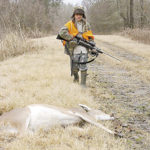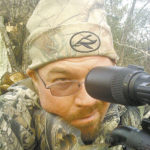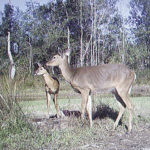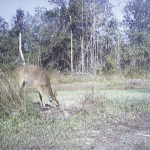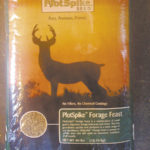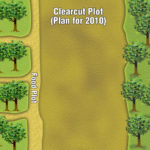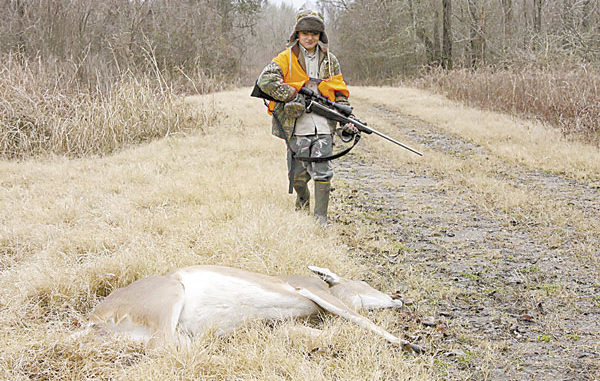
A little more sweat equity produces bigger, healthier plots and a lot more deer on this Washington Parish property.
Where does the time go? It doesn’t seem like a year has passed since I first wrote about the postage-stamp plots that Louisiana Sportsman editor Todd Masson and I began to keep back in 2008. A lot has happened in these last 12 months, and the one thing that I learned about maintaining food plots for deer is that they take a lot of time. Now don’t get me wrong. I spent as much time as humanly possible in our small plots.
But between work, little-league baseball games, church obligations, mowing the grass, planting the garden, picking the garden — you get the picture — I didn’t get to spend nearly as much time working on our plots as I would have liked.
Many were the times that I jumped on the tractor after Sunday lunch to blade the plots into what I perceived to be the perfect shapes with the perfect slopes. However, taking time to get the soil tests done slipped away.
Taking time to plant for the entire season slipped away.
Taking time to plan multiple stand sites slipped away.
After all was plowed and planted, we were basically left with nothing more than UPS label plots rather than postage-stamp plots. In other words, they didn’t get much better, but they did get bigger.
They didn’t get much better because the lessons that we learned in 2008 became victims of circumstance in 2009. Although we learned the importance of soil tests, we didn’t do them. Although we learned the importance of lime, we probably should have put out a little more than we did. And although we learned the importance of year-round plantings, we planted only fall/winter plots.
Maybe next year.
But that’s not to say all was lost. In fact, things got a LOT better. I went from seeing deer on three out of 12 hunts during 2008 to seeing deer 12 out of 15 hunts in 2009. Granted, some of them, two in particular, were the same deer over and over again.
I threw all the Quality Deer Management Association doe-shooting guidelines out the window and let all the does walk. My thinking, rooted in years of don’t-shoot-does brainwashing, was that if I let the does walk with their fawns last season, they would bring back their new fawns this season, and my deer numbers would increase because last year’s fawns would bring their fawns.
Call me stupid, but it seems to me that a doe fawn raised on a particular plot would come back year after year out of habit as long as nobody was messing with it. And each year they would be bringing in new deer with them.
Take into consideration that my line of thinking comes from the fact that we had very few deer on this property before we started managing it two years ago. We had plenty that passed through, but they didn’t have any reason to stay.
That’s why I didn’t shoot a deer off either of these two plots last year. I let them walk hoping they would propagate and bring back more with them this season. And based on deer sightings in my back yard and surrounding pastures, deer are growing more comfortable calling my property home.
Our small plots did undergo some minor changes between the 2008 and 2009 seasons. Namely, we increased their sizes through some bush hogging and some blade work with the tractor.
The clearcut plot took on the resemblance of a bicycle wheel with a central hub that branched off into three spokes. And the cemetery plot was graded to fill in some logging truck tire ruts that extended its overall size.
A nice surprise was that the tractor work on the cemetery plot inadvertently created a small pond that held water throughout the deer season. And the presence of tracks all around its edge indicated that deer were definitely using it as a water source.
With our plots sufficiently cleared and enlarged, Masson and I got to work. Although we didn’t do a soil test, we did put out 400 pounds of pelletized lime per plot in hopes that it would help. We followed that with 300 pounds of 13-13-13 fertilizer.
Since both of the plots have stumps right in their centers, I decided to turn them in to mineral sites. Both stumps got half a sack of dicalcium phosphate and half a sack of red trace minerals.
And on Sept. 14, both plots started holding water after almost 4 inches of rain. Standing water became more and more of a problem as the weeks went on, and neither plot ever fully dried out throughout the season.
On a good note, Sept. 14 was also the day that I noticed that the mineral site at the cemetery plot was getting hammered. Hundreds of tracks blended together around the stump, and a trail was created out of the timber to the stump. The same could not be said of the clearcut plot; it went untouched.
With the forecast calling for rain in the next few days, Masson and I planted both plots on Sept. 19 with Plot Spike Forage Feast with some additional Plot Spike Forage Oats. On the same day, I replenished my mineral stump with one bag of Black Magic. And we discovered our first deer, a very poor-looking doe with a spotted fawn, when we checked the cemetery camera.
I convinced Masson to ride on the back of the bush hog to hold on to an old standing cattle feeder that I wanted to move into a lane off the cemetery plot. We put it in place, and filled it with rice bran.
Unfortunately, we put it in a low spot that held water all season long, and Masson told me later that he didn’t think deer liked standing around in water to eat. I wound up with only one shot of a deer that was close to it but not close enough to claim it was eating from the trough.
Three days later, we received 2 inches of rain. The very next day, we got another inch. And on Sept. 24, it was evident that the cemetery plot was decimated by all the heavy rain. Much of the seed washed into the low spot, and what didn’t was pilled up in little ridges.
On a brighter note, the Black Magic on the cemetery mineral stump was completely gone, and the big mineral stump in the clearcut plot looked like a giant deer lollipop. And although the clearcut plot had some puddling of water, the seed had already begun to sprout.
By Sept. 26, it was obvious that too much of the seed at the cemetery plot had washed away, so I filled in the gaps with a 50-pound sack of Plot Spike Forage Oats. And although I had a feeling I was overdoing it, I poured out another sack of Black Magic on the cemetery mineral stump.
An inspection on Sept. 30 revealed that the cemetery plot had very sparse growth while the clearcut plot was filling in nicely. Both had big bare spots, but the clearcut plot was way ahead of the cemetery plot. Both mineral sites showed continued usage, and my Black Magic was mostly gone again.
Our first evidence of browsing was on Oct. 2. Neither of us bowhunted last season, so we continued to prepare our plots rather than sit in the stand. The bare spots were even more obvious because of the good, green growth that began to define them more and more, so, yet again, I filled in bare spots with more Forage Feast and Forage Oats.
On Oct. 10, I sowed some purple top and white egg turnips in the plots and put up exclusion cages in both areas. By this time, I was getting to the point that I thought I might have been doing too much, so I laid low for 11 days.
When I checked the camera that was set up on the cemetery mineral stump, I couldn’t believe my eyes. I had lots of shots of deer just devouring the minerals stump, dirt and all smack dab in the middle of the day. Although there were signs of browsing on the new, green vegetation, it was obvious that these deer were mineral starved. It was like they couldn’t get enough.
Two weekends before rifle season, I applied 100 pounds of ammonium nitrate to both plots and sprinkled a little sweet feed around their edges. All there was to do at this point was wait on Nov. 21 to arrive.
When it finally did, I didn’t even get out of bed. I decided to make an evening hunt, and when I finally got to my stand, I didn’t dare get in it because there were eight turkeys right on the edge of the cemetery plot. At 5:09 that evening, a doe and fawn walked into this plot.
To see deer on my first hunt was kind of neat. It made me think that I hadn’t put too much pressure on the area and that what we were doing was starting to pay off.
I know a doe and a fawn aren’t much to get excited about, but to see deer that were feeding on the forage that we grew was kind of like growing your own tomatoes. Sweat equity has a way of making things more meaningful.
We’re bumping it up a notch for this upcoming deer season. As I write, a bulldozer is positioned and ready to cut a long lane with three plots cut out of the timber right on the edge of the clear cut. And we’ve got so many ideas that we really don’t know what we’re going to do.
But this I do know. The first thing we’re doing after the bulldozer leaves is collect some soil for a sample. Then I’m going to ask around to see what the surrounding properties plant. Whatever it is, we’re going to plant something different.
And we’re not going to let them walk this year. I want them to call my place home, but I don’t want them to get too comfortable.
